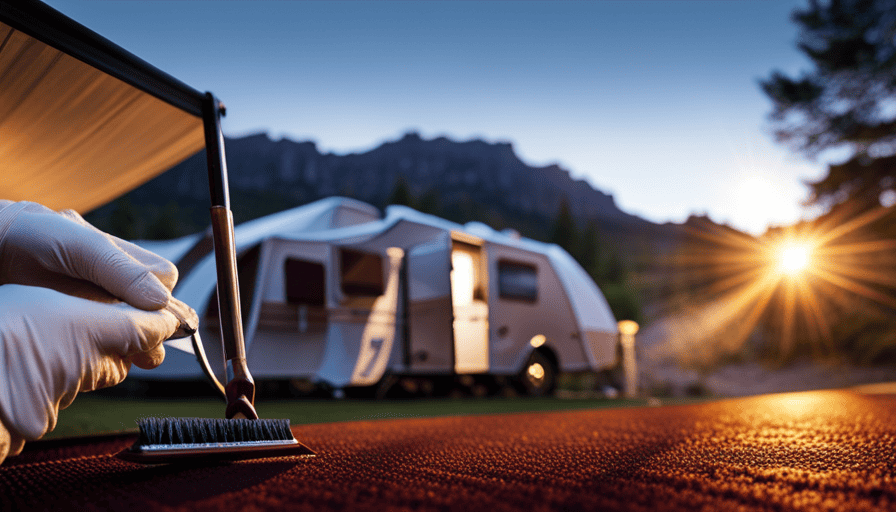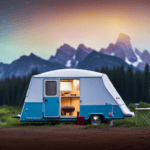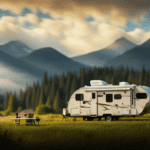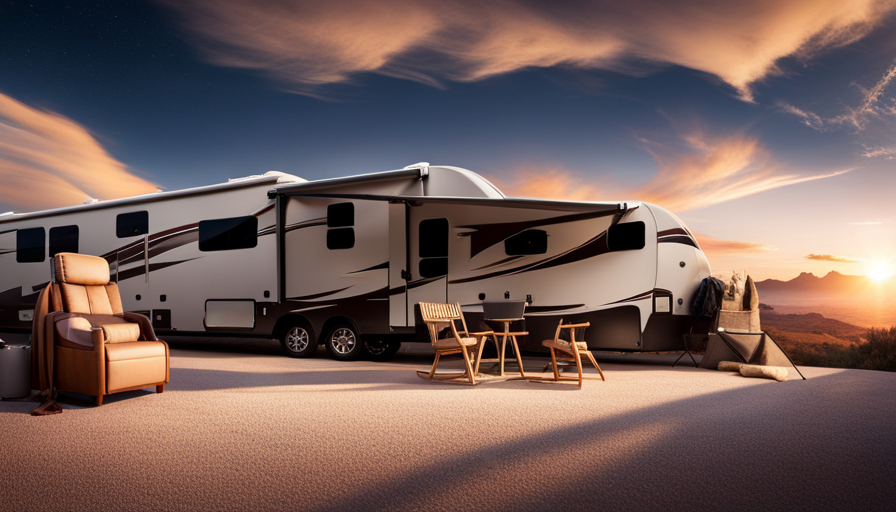Did you know that more than 40 million people in the United States go camping every year? As a passionate camper myself, I recognize the significance of staying connected while traveling. Whether it’s for work, keeping in contact with family and friends, or just streaming your top shows, having WiFi in your camper is crucial.
But how do you get WiFi in your camper? In this article, I will share with you some valuable tips and tricks to ensure you stay connected no matter where your adventures take you. From researching mobile hotspot options to considering satellite internet solutions, exploring campground WiFi options, and even investing in a WiFi extender or booster, there are various ways to achieve a reliable internet connection.
So, let’s dive in and discover how you can get WiFi in your camper and make the most out of your camping experience.
Key Takeaways
- Understand connectivity needs and data usage requirements
- Research mobile hotspot options and compare portable routers and data plans
- Consider satellite internet for coverage in remote areas and faster speeds
- Improve signal strength and speed with WiFi extenders or boosters
Understand Your Connectivity Needs
Imagine lounging in your cozy camper, browsing the web and streaming your favorite shows with seamless WiFi access. To achieve this, it’s important to first understand your connectivity needs.
Identify your data usage requirements by considering how much internet you typically use on a daily basis. Are you a heavy user, constantly streaming videos and downloading large files? Or do you primarily use the internet for basic tasks like checking emails and social media? This will help you determine the amount of data you’ll need for your camping trips.
Another factor to consider is the signal strength in different camping locations. Evaluate the availability and reliability of WiFi signals in the areas where you plan to camp. Research the coverage maps of different service providers to see which ones offer the best coverage in those areas. Additionally, consider investing in a signal booster or antenna to improve your chances of getting a strong signal.
Once you have identified your data usage requirements and evaluated signal strength, you can move on to researching mobile hotspot options. These devices allow you to create your own WiFi network using cellular data. With a mobile hotspot, you can enjoy internet access wherever there is a cellular signal.
Research Mobile Hotspot Options
To find the best mobile hotspot options for your camper, you’ll want to explore a range of reliable internet solutions that can keep you connected on all your adventures.
Start by researching portable routers, which are small devices that create a Wi-Fi network using a cellular connection. These routers come in various models and offer different features, so it’s important to compare their specifications and customer reviews to find one that suits your needs.
Additionally, consider the data plans offered by different providers to ensure you have enough data for your internet usage while on the road. Some plans may have unlimited data, while others have data caps or throttling after a certain limit. By comparing data plans, you can find one that offers the right balance of affordability and data allowance.
Once you have researched mobile hotspot options and compared data plans, you can consider satellite internet solutions for even more reliable connectivity in remote areas.
Consider Satellite Internet Solutions
If you’re looking for a reliable internet solution while on your adventures, consider satellite internet options for seamless connectivity even in remote areas. When comparing satellite internet vs. campground wifi, satellite internet has several benefits. Firstly, satellite internet provides coverage in areas where campground wifi may not reach. This means you can stay connected even when you’re off the beaten path. Secondly, satellite internet offers faster speeds compared to campground wifi, ensuring that you can stream, browse, and video call without any lag or interruptions. Lastly, satellite internet is more reliable as it is not dependent on the number of people connected to the same network, unlike campground wifi which can become slow and unreliable during peak times.
To help you understand the differences between satellite internet and campground wifi more clearly, take a look at the table below:
| Satellite Internet | Campground WiFi | |
|---|---|---|
| Coverage | Wide coverage | Limited coverage |
| Speed | Faster speeds | Slower speeds |
| Reliability | Highly reliable | Can be unreliable |
Considering these advantages, satellite internet is a great option for staying connected in your camper. However, if you want to explore campground wifi options, continue reading the next section.
Explore Campground WiFi Options
When considering staying connected in remote areas, it’s important to explore the campground WiFi options available. While campground WiFi can be a convenient solution for getting internet access in your camper, it’s essential to understand its limitations. Here are three key points to keep in mind:
-
Campground WiFi reliability: The reliability of campground WiFi can vary greatly from one location to another. Some campgrounds may have a robust and stable internet connection, while others may experience frequent outages or slow speeds. It’s important to research and read reviews about the campground’s WiFi reliability before choosing a destination.
-
Campground WiFi speed limitations: Even if the campground WiFi is reliable, it’s common to experience speed limitations. With many campers sharing the same network, the speed can become significantly slower, especially during peak usage times. This can affect activities such as streaming videos or video conferencing.
-
Consider alternative options: If the campground WiFi does not meet your needs, you may want to consider alternative options such as investing in a WiFi extender or booster. These devices can help amplify and extend the WiFi signal, allowing you to access a stronger and more reliable internet connection in your camper.
Considering the limitations of campground WiFi, it’s worth exploring other ways to ensure a reliable internet connection while on the road. Transitioning into the next section, let’s discuss how to invest in a WiFi extender or booster to enhance your connectivity options.
Invest in a WiFi Extender or Booster
Investing in a WiFi extender or booster can significantly improve your connectivity options while camping in remote areas. For example, a camper named Sarah was able to enhance her internet connection by using a WiFi booster, allowing her to work remotely and stay connected with her family during their cross-country road trip.
| WiFi Extender Benefits | WiFi Booster Installation |
|---|---|
| 1. Extends WiFi range | 1. Find a suitable location for the booster |
| 2. Enhances signal strength | 2. Connect the booster to a power source |
| 3. Improves internet speed | 3. Follow the manufacturer’s instructions to set it up |
| 4. Provides better connectivity in dead zones | 4. Connect your devices to the boosted WiFi network |
A WiFi extender works by receiving the existing WiFi signal and then amplifying and rebroadcasting it. This allows you to extend the range of your WiFi network, reaching areas that were previously out of range. Additionally, a WiFi booster can significantly enhance the signal strength, ensuring a more stable and reliable connection.
To install a WiFi booster, you will need to find a suitable location where it can receive a strong WiFi signal. Then, connect it to a power source and follow the manufacturer’s instructions to set it up. Once installed, you can connect your devices to the boosted WiFi network and enjoy improved connectivity.
Now that you understand the benefits of a WiFi extender and how to install one, let’s explore another option to get WiFi in your camper: setting up a personal hotspot with a smartphone or tablet.
Set Up a Personal Hotspot with a Smartphone or Tablet
To establish a personal hotspot in your camper, all you need is a smartphone or tablet. It’s a simple and convenient way to get WiFi on the go.
Here are a few benefits of setting up a personal hotspot:
-
Portability: With a personal hotspot, you can take your WiFi wherever you go. Whether you’re camping in the wilderness or traveling in your camper, you’ll always have a reliable internet connection.
-
Cost-effective: Using your smartphone or tablet as a hotspot eliminates the need to invest in additional devices or pay for separate data plans. It’s a budget-friendly solution for staying connected while on the road.
-
Easy setup: Turning your device into a hotspot is a breeze. Just go to the settings menu, find the hotspot option, and enable it. Then, you can connect your other devices to the network and start browsing.
-
Alternatives: If you don’t have a smartphone or tablet, you can consider other options like portable WiFi routers or MiFi devices. These devices work similarly to personal hotspots and provide internet connectivity for your camper.
Now that you know the benefits of a personal hotspot, let’s explore another option to get WiFi in your camper: installing a WiFi router.
Install a WiFi Router in Your Camper
Now, let’s delve into setting up a WiFi router in your camper for a reliable internet connection wherever you roam.
Installing a WiFi antenna is the first step to ensure a strong signal. Look for a high-gain antenna that can boost the range and signal strength. You can mount it on the roof of your camper for the best reception.
Once the antenna is installed, connect it to the WiFi router inside your camper. Make sure to position the router in a central location to maximize coverage. Connect your devices to the router using the provided WiFi network name and password.
If you experience any issues with your WiFi connection, troubleshooting is essential. Start by checking the connections between the antenna, router, and devices. Ensure that all cables are securely plugged in. If the problem persists, try resetting the router by turning it off and on again. You can also try adjusting the position of the antenna for better reception.
In the next section, we’ll explore how to utilize WiFi network sharing apps to extend your internet connectivity.
Utilize WiFi Network Sharing Apps
Make sure you’re getting the most out of your internet connection on the road by utilizing WiFi network sharing apps on your smartphone or tablet.
These apps allow you to share your device’s internet connection with other devices, such as your camper’s WiFi-enabled devices.
One popular option is to use your smartphone as a personal hotspot, which essentially turns your phone into a WiFi router. By enabling the personal hotspot feature on your phone and connecting your camper’s devices to it, you can access the internet anywhere you have a cellular signal.
There are also dedicated WiFi network sharing apps available on both iOS and Android platforms. These apps allow you to share your device’s internet connection, either through WiFi or Bluetooth, with other devices. Some apps even offer additional features like data usage tracking and the ability to connect multiple devices simultaneously.
By utilizing these WiFi network sharing apps or your phone’s personal hotspot options, you can easily provide WiFi access to your camper’s devices without the need for additional hardware or expensive data plans. However, if you find that your current cellular data plan is insufficient for your needs, you may want to consider upgrading your plan to ensure a more reliable and faster internet connection on the road.
Upgrade Your Cellular Data Plan
If you think your current cellular data plan is already lightning-fast and never leaves you frustrated, then upgrading it would be completely unnecessary. However, if you find yourself constantly struggling with slow internet speeds and poor connectivity while on the road in your camper, it might be time to consider upgrading your cellular data plan.
When looking to upgrade your plan, it’s important to compare data plans from different providers. Look for plans that offer higher data caps and faster speeds. Keep in mind that not all plans are created equal, so it’s essential to read the fine print and understand any limitations or restrictions that may come with the plan.
In addition to comparing data plans, it’s also crucial to check coverage maps for the areas you plan on traveling to. Different providers have varying levels of coverage, so make sure your chosen plan will work well in the locations you frequent the most.
By upgrading your cellular data plan, you can enjoy faster internet speeds and better connectivity while on the road in your camper. However, if you’re still having trouble getting reliable WiFi, it may be time to consult with RV WiFi experts for professional solutions.
With a better data plan in place, you’ll be able to stay connected and enjoy a seamless online experience during your camping adventures.
Consult with RV WiFi Experts for Professional Solutions
Looking for a reliable solution to enhance your internet connection while camping? Consult with RV WiFi experts for professional assistance and enjoy seamless online experiences during your adventures.
These experts specialize in providing consultation services and can help you choose the best options for WiFi installation in your camper. By consulting with RV WiFi experts, you can benefit from their knowledge and experience in setting up internet connectivity in recreational vehicles. They understand the unique challenges and requirements of camper WiFi and can offer tailored solutions to meet your specific needs.
During the consultation process, the experts will assess your camper’s layout, size, and location to determine the most efficient way to install WiFi equipment. They will also take into account factors such as signal strength, antenna placement, and data plans to ensure optimal performance.
With their expertise, RV WiFi experts can recommend the right equipment, such as routers, boosters, and antennas, to maximize your internet connectivity. They can guide you through the installation process, providing step-by-step instructions or even performing the installation themselves.
Consulting with RV WiFi experts not only ensures a professional installation but also saves you time and effort in researching and troubleshooting WiFi issues. So, before you hit the road, consider reaching out to these professionals to enjoy reliable and fast WiFi in your camper.
Frequently Asked Questions
Can I use a traditional home WiFi router in my camper?
Yes, you can use a traditional home WiFi router in your camper. However, it may not be the most practical option. I recommend using a portable hotspot in my camper instead. This device uses cellular data to create a WiFi network, allowing you to connect your devices to the internet while on the go.
Another option to consider is satellite internet, which can provide reliable internet access in remote areas.
What are the benefits of a WiFi extender or booster for my camper?
The benefits of a wifi extender or booster for your camper are immense. With a wifi extender, you can greatly enhance the range and strength of your wifi signal, ensuring a reliable connection throughout your camper.
This means you can stay connected to the internet, stream videos, and work remotely without any interruptions. Additionally, a wifi extender eliminates dead zones, providing comprehensive coverage for all your devices.
It’s an essential tool for anyone seeking efficient camper wifi solutions.
Can I share my WiFi network with other campers in the area?
Yes, it’s possible to share your wifi network with other campers in the area. You can use wifi range extenders designed for campers to increase the range and signal strength of your wifi network. This makes it accessible to neighboring campers. These range extenders can help create a stronger and more reliable wifi connection. It allows multiple campers to connect and enjoy internet access while camping.
How can I upgrade my cellular data plan for better internet connectivity in my camper?
To upgrade my cellular data plan for better internet connectivity in my camper, I would explore alternative options for internet connectivity. This could include investing in a mobile hotspot device or a signal booster to enhance the signal strength.
Additionally, I would consider tips for maximizing cellular data usage in a camper, such as limiting data-heavy activities, using offline content, and optimizing settings for data usage. These approaches can help ensure a reliable and efficient internet connection on the go.
Are there any free or low-cost options for accessing WiFi in campgrounds?
When I was camping last summer, I stumbled upon a hidden gem of a campground that offered free wifi. It was a pleasant surprise to be able to stay connected while enjoying the great outdoors.
In addition to this, many campgrounds now offer low-cost wifi options for campers who need a more reliable and faster connection. So, whether you’re looking for free wifi options or willing to pay a small fee, there are plenty of choices available to keep you connected during your camping adventures.
Conclusion
In conclusion, getting WiFi in your camper is essential for staying connected while on the road. By understanding your connectivity needs and researching different options such as mobile hotspots, satellite internet, and campground WiFi, you can find the perfect solution.
Investing in a WiFi extender or booster, installing a WiFi router in your camper, and utilizing WiFi network sharing apps can further enhance your connection. And don’t forget to upgrade your cellular data plan for a reliable backup.
Consult with RV WiFi experts to ensure a professional and hassle-free setup. Stay connected and enjoy the freedom of the open road!



















